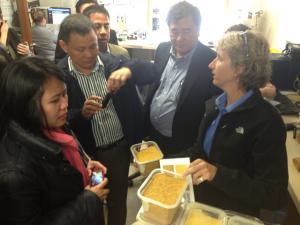By: Adel Yusupov, U.S. Grains Council regional director in Southeast Asia
Southeast Asia is experiencing robust feed demand growth driven by increasing purchasing power, and it is increasingly becoming dependent on outside sources of grain and feed stuffs. This year’s imports of corn are projected to reach 8.0 million metric tons (315 million bushels), with corn import demand driven primarily by Indonesia, Malaysia and Vietnam. Imports of DDGS are projected to stay at the current level, while imports of corn gluten meal are projected to grow 20 percent above last year’s level. Indonesia this year has become the largest U.S. corn gluten meal destination market, surpassing Chile and Egypt.
I am currently in the United States with a team of 13 grain and feedstuffs buyers from Southeast Asia and New Zealand for a crop tour; to view distillers dried grains with solubles (DDGS) and corn gluten meal production facilities; and to learn about the latest developments in the area of container and bulk transportation.
One of the highlights for our foreign guests was a visit to a corn farm utilizing the latest technology for improved ,efficiency and productivity; this was, in fact, the most technologically advanced farm I have ever visited. During the farm tour, team members got chance to take part in the corn harvest by riding in one of the latest combines and tractors. Everyone was impressed by the 21st century farming and the excellent quality of the 2013 corn crop.
Our visits to container transloading facilities demonstrated modern logistics for moving grain and DDGS out from production to international markets. Team members noted the strict export quality control measures taken by the Federal Grain Inspection Service and sellers to ensure the product reaches the customer in the quality it was contracted. We also toured a corn processing facility where several buyers noted the high quality of the corn gluten meal.
Team members during a visit to an ethanol plant learned that DDGS quality has improved significantly and the product has become more uniformed and stable compared to five years ago. Extraction of corn oil has reduced energy levels but increased the levels of protein, hence moving DDGS slightly towards a soybean meal price relationship.
Our visit will wrap up with visits to a grain elevator and an export facility in the Pacific Northwest. These ports are able to load grains, oilseeds and meals, including DDGS, and have infrastructure in place to assure U.S. ability to supply feedstuffs to the growing demand in Asia at a competitive price. Reliability, transparency, and assured quality are key considerations for buyers, and this delegation is certainly gaining an enhanced picture of the U.S. production complex. I am confident that this will translate into increased sales in the future.



